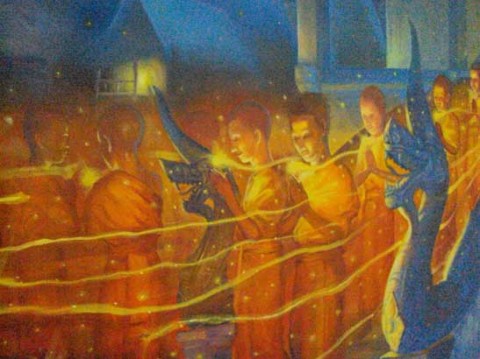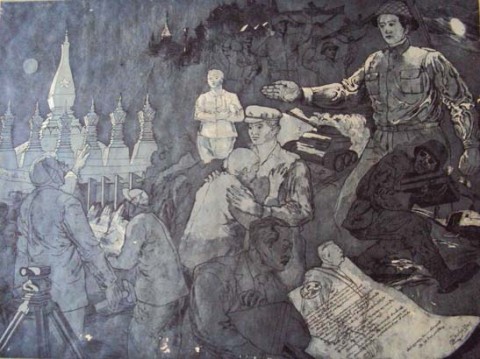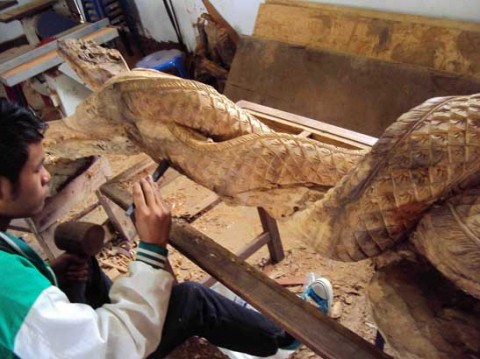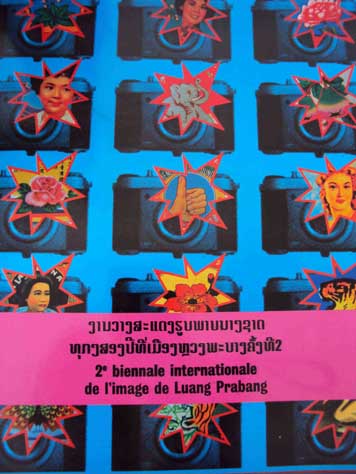

To celebrate the first weekend of our relaunch, we bring you a special report on Contemporary Art in Laos, written by Nathalie Johnston who is studing at the Sotheby’s Institute in Singapore. Laos doesn’t really figure much in our art map when we talk about contemporary practices in South East Asia, however it has vibrant and growing scene and in 2003-2007 was the site of an international community engagement project The Quiet in the Land. This highlight is one of the many which ARTERI will continue to promote in keeping with our interest in contemporary art from the Southeast Asia region. Enjoy and have a great weekend! We’ll be back on Monday! – Eds.
Click here for Part I of Contemporary Art in Laos
~
Trace the themes of contemporary painting today in Laos to its source and you have a combination of Buddhist and Animist spirituality and symbols, textiles and other craft connected to the lifestyle of the Northern ethnic groups of the country, as well as the leftover technique and styles from a handful of French painters who lived and taught in post-colonial Laos, such as Marc LeGuay.
Many experts in the art world would complain of the lack of conceptual, multi-media art with politically charged themes. What these same people neglect to recognize is the world of difference between living with these issues everyday and depicting them through public image and display. For example, two tragic facts of Lao current events are the girls and boys trafficked in and out through the sex trade of Southeast Asia and the loss of life and limb through the millions of undiscovered UXO bombs littered throughout the country. Should these artists really be encouraged to examine these subjects or can they be prompted in a different way, to pursue the subjects which interest them and to which they can relate?

Bounpone Phothisan, Alms, 5 Arts Gallery, Vientiane March 2010
These questions are worth asking, simply because the motivation for the artists is twofold. One is the aforementioned tendency to paint as they were taught and the influence of what is around them, but the other is the very practical concern of financial survival. Laos is an exceedingly poor country, full of tourists willing to buy a painting or two of a group of monks, or the face of Buddha, or the national flower of Laos. Here the practical needs to make a living comes into full play and art stops being about the life of the Lao people and starts being a question of what non-Lao tourists will buy. Where is the happy medium – for an artist to create what she/he wants versus what she/he can make a living off of?
There is no answer, at least not yet. The Lao people are in a period of transition – finally recovering from decades of hardship, recently admitted into the ASEAN network, and slowly allowing investment and infrastructure from the outside. The art is undergoing a similar makeover. What we discovered was an unwavering dedication to the future of the Lao people within the arts.

Final Thesis Project at Bulgaria School of Fine Art, Kongphat Luangrath, work completed 1980s. Photo taken March 2010
In Vientiane it is Kongphat Luangrath and Misouda Heuangsoukkhoun, two Laotian gallery owners devoted to pushing the young and older artists to find their own voice through group shows, exhibitions and residencies in other countries. Kongphat is also a professor at the Faculty of Fine Art and aims to shift the teaching style to a more independent based program, geared toward students digging deeper and expanding their knowledge of art history and criticism, all the while working toward drawing their own conclusions. Misouda, who is fluent in English, is working on writing and translating for the Lao artists, giving them a larger and more diverse international audience.
Also in Vientiane is Michael Chan, a Singaporean gallery owner who places Lao artists under contract, and in return supplies materials and research trips to neighboring countries. This creates a complicated but necessary transition onto the world stage of competitive art consultation. Chan will act as a bridge in the future. Carol Cassidy breathes new life into the world of textiles, creating a brand new avenue of pattern and symbol, combining Lao traditional technique with her own experience in Swedish loom work. By teaching Lao weavers these complex methods, she acts as a trigger for change. These weavers pass these practices on, putting a contemporary spin on an age-old practice.

Sculpture Student at Vientiane Faculty of Fine Arts
There are several other important players in Vientiane, including Treasures of Asia gallery, the owner Dr. Bernard Gay who published the first book on Lao contemporary art. Another professor at the Faculty of Fine Arts, Sai Noy, is currently in Tokyo, taking up a residency studying video art, which he intends to bring back to Laos. Vientiane, the current capital city and center of development in Laos, is sure to set the stage for Lao contemporary art getting international acclaim in the next decade.
Luang Prabang offers an equally intriguing but slightly different view of the future. In Luang Prabang there exists the textile studios, which offer the same opportunities to local weavers as they do in Vientiane, but their interpretations are far different. Fashion is the name of the game in Luang Prabang textiles. Having held a fashion show in February, new designs of casual to formal wear of the most up-to-date fashions worldwide incorporate Lao textiles as a vital part of the fabric make-up. Combining the contemporary and the traditional elevates the status of the original while paying the utmost respect to the craft.

Photo Albums of Young Lao Photographers, @ My Library Published Work, Luang Prabang March 2010
Photography and film are also in the mix of the Luang Prabang art scene. @MyLibrary is a not-for-profit organization started by Carol Kresge, devoted to children in and around the city, where they can use computers, learn about new programs and have rental access to digital cameras. One participant was included in the 2nd Annual Luang Prabang Image Festival, held at the National Palace Museum by the French Language Center. The self-proclaimed photographers are utilizing Photoshop and other programs to create their own works of art, sold at @MyLibrary for under $25 USD. Similarly, American, Gabriel Kuperman, is currently working hard to hold the first Lao Film Festival in Luang Prabang. He feels that the exposure will open locals to a new cinematic experience (there are no movie theaters in Laos) by bringing in film from the rest of the ASEAN nations.

2nd Photo Biennale Poster, Luang Prabang, February 2010
Several other galleries have sprouted in the surrounds of the gorgeous temples, which allow Luang Prabang to hold a UNESCO World Heritage Site title. Photography is the most common medium; a possible result of the influx of tourists plus the incredibly photogenic landscape of temples and the Mekong River. Some forms of contemporary art not present are performance and land art, a shame considering the mediums are ideal for those with few resources. There are no known Lao performance artists, however, and the likelihood of either showing up in the future for this simple reason is slim.
When considering the transitions that Lao art has made thus far, one must keep in mind the pride and protective nature the Lao people hold to their culture and lifestyle. They will create a discourse in contemporary art but they will do it at their own pace, as time and resources allow. They will use their incredible talent to create something new and uniquely Lao. Whether it is textile or painting, photography or scenes carved in wood at the entrance to a temple, their creativity is not only real but also valid. The contemporary arts are all their own and, if projecting the future of their art world, one could simply say it will no doubt be a bright one.
~
Click here for Part I of Contemporary Art in Laos
~
Nathalie Johnston is from Alexandria, Virginia in the United States. She is studying for her Masters in Contemporary Art in Singapore at the Sotheby’s Institute. In addition to Laos, she has a particular interest in Myanmar and will be writing her thesis pertaining to the performance and environmental artists in Yangon beginning in June. She hopes to remain in Southeast Asia to live, work and pursue her interests in the arts.
Sorry, the comment form is closed at this time.
Interesting article. I have some of the collection from Lao artist I like to shere it with Natalie.
Very well written article.
Thank you for spot lightening the arts and artists of Laos. More needs to be written about it.. there is such an amazing group of talented artists here!